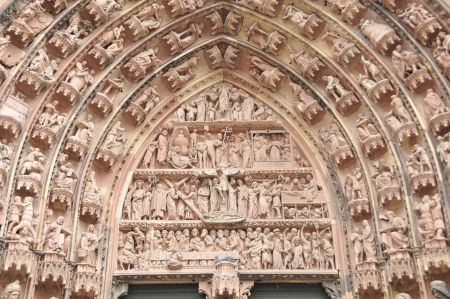Bicycle Trip in Strasbourg and at Notre-Dame Cathedral
We started our first day in Strasbourg early. One of us had to go to the bakery to buy croissants and warm baguette.
Patrick’s house is at a distance of 800 meters from the European Parliament, which is hosted for the European Union negotiations. In Patrick’s house, we had a satisfying breakfast with baguettes and croissants that just came out of the oven to our table. Then, we went out for a spin with our bicycles. Under the guidance of Patrick, while we were touring around with bicycles for the first time through the historic old city center of Strasbourg, marvelous bicycle paths of the city attracted our attention.
Passing by the European Parliament, we headed towards the city center. With the help of markings and signboards that used for bicycle paths in the city, we get used to this amusing and healthy alternative of transportation vehicle quickly.
Notre-Dame Cathedral Square in Strasbourg
The historical old city of Strasbourg, Grande Île (Grand Island), is an island surrounded by the Ill River, which is one of the branches of the Rhine River. In 1988, Grande Île was listed as UNESCO World Heritage Site and still keeps its place. Notre-Dame Cathedral Square, which is one of the most beautiful squares of Europe, and La Petite France (Little France) neighborhood are the most glamorous visuals of the Grande Île trip.
At the heart of the old city, there is Notre-Dame Cathedral that considered one of the most beautiful examples of early gothic period architecture. Nowadays, it is the 6th highest church of Europe, besides its grandness, with its harmony, elegance and delicacy it erects as the proof of Victor Hugo’s “gigantic and delicate marvel” description.
Eventually we took leave from the frontal carving and ornamentations, then, made a move to see the inside of the cathedral. The array of bright colors with the light gliding from the stained glass windows, presents captivating view to us. In our opinion; the cathedral, which must be experienced personally with its eye-catching beauty and elusive structure, must be “holy” indeed.
Most of the stained glass windows remain from the 14th century, some of them late 12th century (northern transept of the church) and 13th century (“The Emperor Window” in the northern corridor) and a few of them 20th century (southern transept).
In case you take the chance of climbing the southern tower, there will be 330 stairs you need to go up before reaching the marvelous panoramic view. A great deal of narrow streets, interesting roofs of the historical city, the European Union region, the Vosges Mountains, the Rhine Valley and the Black Forest are among the landscapes of the city that you can see from a wonderful angle by bird’s eye view.
One of the most interesting elements in the cathedral is the sculpture of “Christ on the Mount of Olives” that made as a grave ornament in 1498.
In spite of the existence of a pipe organ remaining from 1260 was mentioned, the oldest parts of the pipe organ in the cathedral were from 1385.
Astronomical clock at the first clock tower
The second and the more assertive clock was designed by mathematician Christian Herlin in the 16th century. Its visual richness of decoration and complexity of astronomic device were the elements that drew attention. Today, many pieces of the clock are shown in the Strasbourg Museum of Decorative Arts.
Existing today, the third clock was built by Jean-Baptiste Schwilgué in 1843. Designing a new mechanism, before starting the construction, he made preparations with 30 workers during a year. Although the visitors are impressed by the extremely well chiseled figurines, the most attractive part of the clock is the mechanism behind.
The clock, which is a work of art and brilliance, shows the movements of the earth, moon and even planets that known until it was built. Also, it is a calendar that regulated for eternity. Hourly, the figures start to move for a parade.
The beauty of Strasbourg Notre-Dame Cathedral was the inspiration of many famous men in history. Here are some of them:
Stendhal: "The vault of Strasbourg is one of the most striking monuments I have ever seen".
Goethe: "The more I contemplate the facade of the Cathedral, the more I am convinced of my first impression that its loftiness is linked to its beauty."
Victor Hugo: "The church portals are beautiful, particularly the Roman portal; there are truly superb figures on horseback, the rose-window is noble and well-cut, the entire front of the church is a clever poem. But the true triumph of this Cathedral is the spire...”.
Besides of Notre-Dame Cathedral with the picturesque square, it is worth to see the half-timbered houses of splendid German design that belongs to the Middle Ages and the Renaissance Period. The Kammerzell House, which was constructed in 1427, is the most famous of these German designs. It is one of the oldest and characteristic structures of the city and draws attention with its timber ornaments and 70 windows.
The city, which was one of the most important cities of the Holy Roman German Empire in the Middle Ages, has the intense characteristics of German and French culture. In short, this distinguished city of the Alsace region, Strasbourg still asks itself if it is German or French.
The Rohan Palace is located near the tunnel and it is quite close to the square. The palace, which was the center of the Rohan Cardinals at one time, today contains three of nine museums in Strasbourg within itself. These museums are; The Archaeological Museum, The Museum of Decorative Arts and The Museum of Fine Arts.
Please read as well:
Koman Lake and Dam - More impressions about the ferry trip
Cultural Monument Wiener Riesenrad at Prater
-
-
-
-
-
-
https://www.alaturka.info/en/roman-road-project/2483-the-heart-of-strasbourg-and-notre-dame-cathedral/amp#sigProId9de2a70b50
